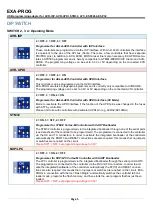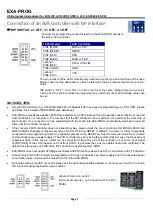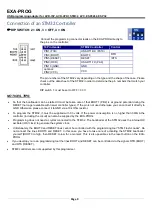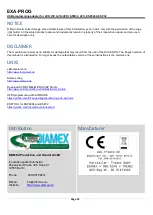
EXA-PROG
USB programming adapter for AVR-ISP, AVR-UPDI, STM32, LPC, ESP8266, ESP32
Page 2
INSTALLATION
Connect the EXA-PROG via a mini USB cable with any USB-2.x or USB 3.x port of your PC or laptop.
Windows 7 and 8.x
EXA-PROG uses a virtual COM port. With Windows 7 and 8.x the driver file needs to be installed first. Click on the respective
entry in the device manager of Windows, in the "Driver" tab click on "update driver". Then select the file
prog-isp.inf
of the
EXA-PROG program package.
Windows 8.x
If you are still using Windows 8.x you may have to disable
“driver signature enforcement”. You can easily find out how this
works with a Google search. If possible, you should consider going for Windows 10 or 11.
Windows 10/11
With Windows 10 or 11 there is no driver installation necessary. Each component registers itself as a
“serial USB device
(COMx)“.
The best way to test which COM port is valid for your used component is by starting the EXA-PROG tool and clicking on
the list of COM ports before and after you plugged in the component. The COM port that was added is your EXA-PROG.
EXA-PROG
doesn’t come with its own program for programming microcontrollers. EXA-PROG’s firmware is compatible to
many existing programming tools of the manufacturers or to freely available tools.
In its delivery condition EXA-PROG is set to the mode AVR-ISP with 3.3V (all DIP switches to OFF).
In the AVR-ISP mode EXA-PROG is compatible to
STK500
and works with AVR/ATMEL/MICROCHIP Studio as well as
AVRDUDE (Arduino, Bascom).
Notice: With Windows 10 or 11 please only use ATMEL/MICROCHIP Studio 7.x or higher. Older versions do not work.
In the UPDI mode EXA-PROG emulates a
JTAG2UPDI
programmer. At the moment this can only be used with
AVRDUDE
(see link at the end of this manual).
The ESP mode is compatible to
ESPTOOL
(esptool.py, esptool.exe).
The programming modes STM32 and NXP/LPC are largely intended for the use of individual programming tools.
Please always pay attention that the DIP switches are set fitting to the microcontroller that is to be programmed. Please be
sure to pay attention of the programming voltage. AVR controllers can be operated with 3.3V and 5V. Almost all 32-bit
microcontrollers can ONLY be operated with 3.3V.
Do not flip the DIP switches throughout the programming process. Switching always leads to a reset of the programmer.
This is indicated by a short flicker of the red LED. A constantly glowing green LED indicates that the programmer is ready
for use.
Do not push the RESET button throughout the programming process. The programming gets canceled and the data in the
flash memory of the microcontroller can be invalid.































